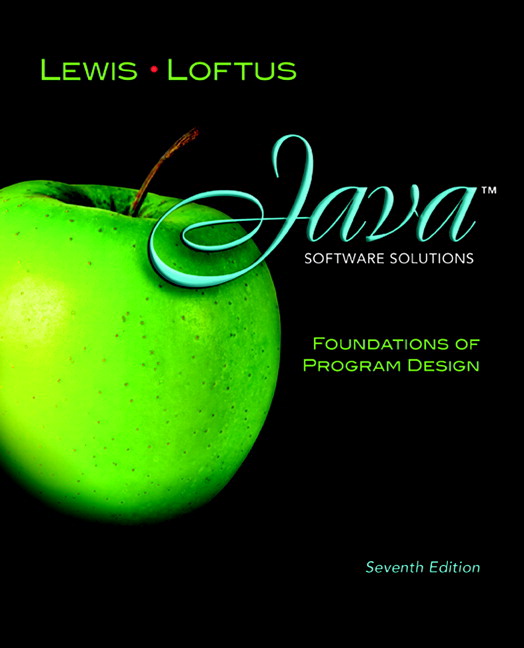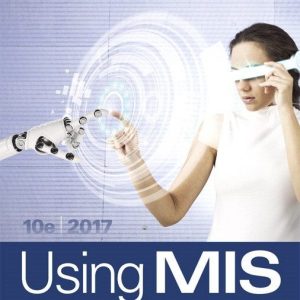This is completed downloadable of Test Bank for Java Software Solutions: Foundations of Program Design, 7/E 7th Edition John Lewis, William Loftus

Product Details:
ISBN 10: 0132149184
ISBN13: 978-0132149181
Author: John Lewis, William Loftus
Java Software Solutions teaches a foundation of programming techniques to foster well-designed object-oriented software. Heralded for its integration of small and large realistic examples, this worldwide best-selling text emphasizes building solid problem-solving and design skills to write high-quality programs.
Table of Content:
Chapter 1 Introduction 1 1.1 Computer Processing 2 Software Categories 3 Digital Computers 5 Binary Numbers 7 1.2 Hardware Components 10 Computer Architecture 10 Input/Output Devices 12 Main Memory and Secondary Memory 13 The Central Processing Unit 17 1.3 Networks 19 Network Connections 19 Local-Area Networks and Wide-Area Networks 21 The Internet 22 The World Wide Web 24 Uniform Resource Locators 25 1.4 The Java Programming Language 26 A Java Program 27 Comments 29 Identifiers and Reserved Words 31 White Space 33 1.5 Program Development 35 Programming Language Levels 36 Editors, Compilers, and Interpreters 38 Development Environments 40 Syntax and Semantics 41 Errors 42 1.6 Object-Oriented Programming 43 Problem Solving 44 Object-Oriented Software Principles 45 Chapter 2 Data and Expressions 61 2.1 Character Strings 62 The print and printlnMethods 62 String Concatenation 64 Escape Sequences 66 2.2 Variables and Assignment 69 Variables 69 The Assignment Statement 71 Constants 73 2.3 Primitive Data Types 73 Integers and Floating Points 74 Characters 75 Booleans 77 2.4 Expressions 77 Arithmetic Operators 78 Operator Precedence 78 Increment and Decrement Operators 83 Assignment Operators 84 2.5 Data Conversion 85 Conversion Techniques 87 2.6 Interactive Programs 88 The ScannerClass 88 2.7 Graphics 93 Coordinate Systems 94 Representing Color 95 xx CONTENTS CONTENTS xxi 2.8 Applets 96 Executing Applets Using the Web 98 2.9 Drawing Shapes 99 The GraphicsClass 99 Chapter 3 Using Classes and Objects 113 3.1 Creating Objects 114 Aliases 116 3.2 The StringClass 118 3.3 Packages 121 The import Declaration 122 3.4 The RandomClass 124 3.5 The MathClass 127 3.6 Formatting Output 130 The NumberFormatClass 130 The DecimalFormatClass 133 The printfMethod 135 3.7 Enumerated Types 135 3.8 Wrapper Classes 138 Autoboxing 141 3.9 Components and Containers 141 Frames and Panels 142 3.10 Nested Panels 145 3.11 Images 148 xxii CONTENTS Chapter 4 Writing Classes 155 4.1 Anatomy of a Class 156 Instance Data 161 UML Class Diagrams 162 4.2 Encapsulation 163 Visibility Modifiers 164 Accessors and Mutators 165 4.3 Anatomy of a Method 166 The returnStatement 167 Parameters 169 Local Data 170 Bank Account Example 171 4.4 Constructors Revisited 175 4.5 Graphical Objects 175 4.6 Graphical User Interfaces 184 4.7 Buttons 185 4.8 Text Fields 189 Chapter 5 Conditionals and Loops 201 5.1 Boolean Expressions 202 Equality and Relational Operators 203 Logical Operators 204 5.2 The ifStatement 207 The if-elseStatement 209 Using Block Statements 212 The Conditional Operator 217 Nested ifStatements 218 CH004_TOC.qxd 4/7/04 5:56 PM Page xxii CONTENTS xxiii 5.3 Comparing Data 220 Comparing Floats 220 Comparing Characters 221 Comparing Objects 222 5.4 The switchStatement 223 5.5 The whileStatement 227 Infinite Loops 232 Nested Loops 234 Other Loop Controls 237 5.6 Iterators 238 Reading Text Files 239 5.7 The doStatement 242 5.8 The forStatement 245 Iterators and forLoops 249 Comparing Loops 251 5.9 Drawing with Loops and Conditionals 251 5.10 Determining Event Sources 254 5.11 Dialog Boxes 260 5.12 More Button Components 263 Check Boxes 264 Radio Buttons 267 xxiv CONTENTS Chapter 6 Object-Oriented Design 287 6.1 Software Development Activities 288 6.2 Identifying Classes and Objects 289 Assigning Responsibilities 291 6.3 Static Class Members 291 Static Variables 292 Static Methods 292 6.4 Class Relationships 296 Dependency 296 Dependencies Among Objects of the Same Class 296 Aggregation 303 The thisReference 305 6.5 Interfaces 309 The Comparable Interface 315 The IteratorInterface 316 6.6 Enumerated Types Revisited 316 6.7 Method Design 319 Method Decomposition 320 Method Parameters Revisited 325 6.8 Method Overloading 328 6.9 Testing 333 Reviews 334 Defect Testing 334 6.10 GUI Design 336 CONTENTS xxv 6.11 Layout Managers 337 Flow Layout 339 Border Layout 344 Grid Layout 348 Box Layout 350 6.12 Borders 354 6.13 Containment Hierarchies 358 Chapter 7 Arrays 369 7.1 Array Elements 370 7.2 Declaring and Using Arrays 371 Bounds Checking 373 Alternate Array Syntax 379 Initializer Lists 379 Arrays as Parameters 380 7.3 Arrays of Objects 381 7.4 Command-Line Arguments 392 7.5 Variable Length Parameter Lists 394 7.6 Two-Dimensional Arrays 398 Multidimensional Arrays 402 7.7 The ArrayListClass 403 Specifying an ArrayList Element Type 404 ArrayListEfficiency 406 7.8 Polygons and Polylines 407 The PolygonClass 408 xxvi CONTENTS 7.9 Mouse Events 412 7.10 Key Events 420 Chapter 8 Inheritance 437 8.1 Creating Subclasses 438 The protectedModifier 443 The superReference 444 Multiple Inheritance 448 8.2 Overriding Methods 449 Shadowing Variables 451 8.3 Class Hierarchies 452 The ObjectClass 454 Abstract Classes 455 Interface Hierarchies 457 8.4 Visibility 458 8.5 Designing for Inheritance 461 Restricting Inheritance 462 8.6 The Component Class Hierarchy 463 8.7 Extending Adapter Classes 465 8.8 The TimerClass 469 CONTENTS xxvii Chapter 9 Polymorphism 481 9.1 Late Binding 482 9.2 Polymorphism via Inheritance 483 9.3 Polymorphism via Interfaces 496 9.4 Sorting 498 Selection Sort 498 Insertion Sort 505 Comparing Sorts 506 9.5 Searching 507 Linear Search 507 Binary Search 511 Comparing Searches 513 9.6 Designing for Polymorphism 513 9.7 Event Processing 514 9.8 File Choosers 515 9.9 Color Choosers 518 9.10 Sliders 521 Chapter 10 Exceptions 531 10.1 Exception Handling 532 10.2 Uncaught Exceptions 533 10.3 The try-catchStatement 534 The finallyClause 537 xxviii CONTENTS 10.4 Exception Propagation 538 10.5 The Exception Class Hierarchy 541 Checked and Unchecked Exceptions 544 10.6 I/O Exceptions 545 10.7 Tool Tips and Mnemonics 549 10.8 Combo Boxes 556 10.9 Scroll Panes 562 10.10 Split Panes 564 Chapter 11 Recursion 575 11.1 Recursive Thinking 576 Infinite Recursion 577 Recursion in Math 577 11.2 Recursive Programming 578 Recursion vs. Iteration 581 Direct vs. Indirect Recursion 581 11.3 Using Recursion 582 Traversing a Maze 582 The Towers of Hanoi 588 11.4 Recursion in Graphics 593 Tiled Pictures 593 Fractals 596 CONTENTS xxix Chapter 12 Collections 611 12.1 Collections and Data Structures 612 Separating Interface from Implementation 612 12.2 Dynamic Representations 613 Dynamic Structures 613 A Dynamically Linked List 614 Other Dynamic List Representations 619 12.3 Linear Data Structures 621 Queues 621 Stacks 622 12.4 Non-Linear Data Structures 624 Trees 625 Graphs 626 12.5 The Java Collections API 628 Generics 628 Appendix A Glossary 639 Appendix B Number Systems 665 Appendix C The Unicode Character Set 673 Appendix D Java Operators 677 Appendix E Java Modifiers 683 Appendix F Java Coding Guidelines 687 Appendix G Java Applets 693 xxx CONTENTS Appendix H Regular Expressions 695 Appendix I JavaDoc 697 Appendix J The PaintBox Project 703 Appendix K GUI Events 715 Appendix L Java Syntax 719 Appendix M The Java Class Library 733 Index 893 Preface Welcome to the Fifth Edition of Java Software Solutions, Foundations of Program Design. We are pleased that this book has served the needs of so many students and faculty over the years. This edition is designed to further enhance the pedagogy of introductory computing. What's New in the Fifth Edition The overall vision of the book has not changed significantly from that of the third edition. The emphasis remains on presenting underlying core concepts. The Graphics Track sections in each chapter still segregate the coverage of graphics and graphical user interfaces. The casual writing style and entertaining examples still rule the day. The changes made for this edition are designed to permeate and reinforce the pedagogy of the material. These changes also address some of the trends that are happening in many Java programming courses. Specifically: The discussions and examples fully embrace the Java 2 Standard Edition 5.0, including coverage of: > The standard Scanner class, which simplifies keyboard input and parsing. > Enumerated types. > Autoboxing, which automatically converts primitives to wrapper objects and vice versa. > Variable length parameter lists. > The enhanced for loop, which facilitates iterating over a collection. > Generic types, which facilitate the definition of collection classes. We provide a smoother evolution of object-oriented concepts, including a brief introduction to the most essential elements of writing classes prior to covering conditionals and loops. We incorporate class examples into all remaining chapters, adding key aspects of class design as appropriate. We place a stronger emphasis on object-oriented design, including techniques for identifying classes, objects, and their relationships. We have reorganized the flow of graphical user interface (GUI) topics into a more logical order throughout the Graphics Track sections of each chapter. The topics from the third edition's "catch all" GUI chapter have been integrated throughout the text. We present most example programs dealing with GUIs and graphics as framebased Java applications instead of applets. Details of applets are now provided in an appendix. The reference material in the appendices has been augmented with new topics, including an overview of GUI events and a summary of regular expressions for parsing using the Scanner class. A whole suite of new and improved supplements is available with this edition. The supplements are discussed in detail later in the preface. Cornerstones of the Text This text is based on the following basic ideas that we believe make for a sound introductory text: > True object-orientation. A text that really teaches a solid object-oriented approach must use what we call object-speak. That is, all processing should be discussed in object-oriented terms. That does not mean, however, that the first program a student sees must discuss the writing of multiple classes and methods. A student should learn to use objects before learning to write them. This text uses a natural progression that culminates in the ability to design real object-oriented solutions. > Sound programming practices. Students should not be taught how to program; they should be taught how to write good software. There's a difference. Writing software is not a set of cookbook actions, and a good program is more than a collection of statements. This text integrates practices that serve as the foundation of good programming skills. These practices are used in all examples and are reinforced in the discussions. Students learn how to solve problems as well as how to implement solutions. We introduce and integrate basic software engineering techniques throughout the text. > Examples. Students learn by example. This text is filled with fully implemented examples that demonstrate specific concepts. We have intertwined small, readily understandable examples with larger, more realistic ones. There is a balance between graphics and nongraphics programs. > Graphics and GUIs. Graphics can be a great motivator for students, and their use can serve as excellent examples of object-orientation. As such, we use them throughout the text in a well-defined set of sections that we call the Graphics Track. This coverage includes the use of event processing and GUIs. Students learn to build GUIs in the appropriate way by using a natural progression of topics. The Graphics Track can be avoided entirely for those who do not choose to use graphics. Paths Through the Text This book is designed to be flexible, so that instructors can tailor its presentation to the needs of their students. Instructors can take a variety of paths through the text. Graphics can be emphasized or deemphasized as desired. Chapter Breakdown Chapter 1 (Introduction) introduces computer systems in general, including basic architecture and hardware, networking, programming, and language translation. Java is introduced in this chapter, and the basics of general program development, as well as object-oriented programming, are discussed. This chapter contains broad introductory material that can be covered while students become familiar with their development environment. Chapter 2 (Data and Expressions) explores some of the basic types of data used in a Java program and the use of expressions to perform calculations. It discusses the conversion of data from one type to another, and how to read input interactively from the user with the help of the standard Scanner class. Chapter 3 (Using Classes and Objects) explores the use of predefined classes and the objects that can be created from them. Classes and objects are used to manipulate character strings, produce random numbers, perform complex calculations, and format output. Enumerated types are also discussed. Chapter 4 (Writing Classes) explores the basic issues related to writing classes and methods. Topics include instance data, visibility, scope, method parameters, and return types. Encapsulation and constructors are covered as well. Some of the more involved topics are deferred to or revisited in Chapter 6. Chapter 5 (Conditionals and Loops) covers the use of boolean expressions to make decisions. All related statements for conditionals and loops are discussed, including the enhanced version of the for loop. The Scanner class is revisited for iterative input parsing and reading text files. Chapter 6 (Object-Oriented Design) reinforces and extends the coverage of issues related to the design of classes. Techniques for identifying the classes and objects needed for a problem and the relationships among them are discussed. This chapter also covers static class members, interfaces, and the design of enumerated type classes. Method design issues and method overloading are also discussed. Chapter 7 (Arrays) contains extensive coverage of arrays and array processing. Topics include command-line arguments, variable length parameter lists, and multidimensional arrays. The ArrayList class and its use as a generic type is explored as well. Chapter 8 (Inheritance) covers class derivations and associated concepts such as class hierarchies, overriding, and visibility. Strong emphasis is put on the proper use of inheritance and its role in software design. Chapter 9 (Polymorphism) explores the concept of binding and how it relates to polymorphism. Then we examine how polymorphic references can be accomplished using either inheritance or interfaces. Sorting is used as an example of polymorphism. Design issues related to polymorphism are examined as well. Chapter 10 (Exceptions) explores the class hierarchy from the Java standard library used to define exceptions, as well as the ability to define our own exception objects. We also discuss the use of exceptions when dealing with input and output, and examine an example that writes a text file. Chapter 11 (Recursion) covers the concept, implementation, and proper use of recursion. Several examples from various domains are used to demonstrate how recursive techniques make certain types of processing elegant. Chapter 12 (Data Structures) introduces the idea of a collection and its underlying data structure. Abstraction is revisited in this context and the classic data structures are explored. Generic types are introduced as well. This chapter serves as an introduction to a CS2 course. Supplements A variety of supplemental materials is available for this text. The following resources are available for all students at www.aw-bc.com/cssupport: > Source code for all the programs in the text. > Various Java development environments; these are also on the CD in the back of this book. > The Keyboard class, for those who want access to the author-provided input class that was used in previous editions of the book. In this edition, it has been supplanted by the new standard Scanner class. > Lab manual; lab exercises are designed to accompany the topic progression in the text. > Addison-Wesley's CodeMate; an online environment that brings the text to life. A free subscription, included on the card in the front of this text, allows you to work with many of the text's Code Listings and Programming Projects to improve your programming skills. In addition, the following supplements are available to qualified instructors. Please contact your Addison-Wesley sales representative, or send e-mail to [email protected], for information on how to access them: > Presentation Slides; in PowerPoint. > Solutions; includes solutions to all exercises and programming projects. > Test Bank in powerful test generator software; includes a wealth of free response, multiple choice, and true/false type questions. > Lab Manual; lab exercises are designed to accompany the topic progression in the text. A printed version of this manual is also available. Acknowledgments We are most grateful to the faculty and students from around the world who have provided their feedback on previous editions of this book. We are pleased to see the depth of the faculty's concern for their students and the students' thirst for knowledge. Your comments and questions are always welcome. We stand in awe of the talent and heroic effort demonstrated by the team at Addison-Wesley. Michael Hirsch, our editor, has amazing insight and commitment. Susan Hartman Sullivan has been a brilliant guiding force since this book's inception. We thank Marketing Manager Michelle Brown and Marketing Coordinator Lesly Hershman for making sure that instructors understand the pedagogical advantages of the text. The cover and interior design were designed by the skilled talents of Joyce Wells. Jeff Holcomb led the amazing production effort given completely unreasonable time constraints. The Addison-Wesley folks are supported by the phenomenal team at Argosy Publishing, including Daniel Rausch and Edalin Michael. We thank all of these people for ensuring that this book met the highest quality standards. Special thanks go to the following people who provided valuable advice to us about this edition via their participation in focus groups, interviews, and reviews: Robert Burton; Brigham Young University; Robert Cohen; University of Massachusetts, Boston; Christopher Eliot; University of Massachusetts, Amherst; Matt Evett; Eastern Michigan University; James Heliotis; Rochester Institute of Technology; Blayne Mayfield; Oklahoma State University; Carolyn Schauble; Colorado State University; and Faye Navabi-Tadayon; Arizona State University. The reviewers of previous editions of this text, as well as many other instructors and friends, have provided valuable feedback. They include: Lewis Barnett University of Richmond Tom Bennet Mississippi College Gian Mario Besana DePaul University Hans-Peter Bischof Rochester Institute of Technology Robert Burton Brigham Young University James Cross Auburn University Eman El-Sheikh University of West Florida John Gauch University of Kansas Chris Haynes Indiana University Laurie Hendren McGill University Mike Higgs Austin College Karen Kluge Dartmouth College Jason Levy University of Hawaii Peter MacKenzie McGill University Blayne Mayfield Oklahoma State University Lawrence Osborne Lamar University Barry Pollack City College of San Francisco B. Ravikumar University of Rhode Island David Riley University of Wisconsin (La Crosse) Jerry Ross Lane Community College Carolyn Schauble Colorado State University Arjit Sengupta Georgia State University Vijay Srinivasan JavaSoft, Sun Microsystems, Inc. Katherine St. John Lehman College, CUNY Ed Timmerman University of Maryland, University College Shengru Tu University of New Orleans Paul Tymann Rochester Institute of Technology John J. Wegis JavaSoft, Sun Microsystems, Inc. Linda Wilson Dartmouth College David Wittenberg Brandeis University Wang-Chan Wong California State University (Dominguez Hills) Thanks also go to my colleagues at Villanova University who have provided so much wonderful feedback. They include Bob Beck, Cathy Helwig, Dan Joyce, Anany Levitin, Najib Nadi, Beth Taddei, and Barbara Zimmerman. Special thanks go to Pete DePasquale of The College of New Jersey for the design and evolution of the PaintBox project, as well as the original Java Class Library appendix. Many other people have helped in various ways. They include Ken Arnold, Kevin Henry, John Loftus, Sebastian Niezgoda, Sammy Perugini, and Tim Herman (Dexter Systems). Our apologies to anyone we may have forgotten. The ACM Special Interest Group on Computer Science Education (SIGCSE) is a tremendous resource. Their conferences provide an opportunity for educators from all levels and all types of schools to share ideas and materials. If you are an educator in any area of computing and are not involved with SIGCSE, you're missing out.
People Also Search:
java software solutions foundations of program design 7/e
java software solutions foundations of program design 7/e 7th edition
java software solutions foundations of program design 7/e 7th edition download scribd
java software solutions foundations of program design 7/e 7th edition test bank download pdf





